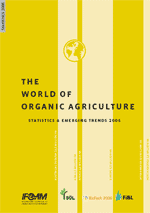Bonn/Frick/Bad
Duerkheim/Nuernberg, Germany
February 14, 2006
IFOAM, FiBL and SOEL present
new facts and figures about organic farming at BioFach 2006
The
International Federation of Organic Agriculture Movements
(IFOAM), the Swiss Research
Institute of Organic Agriculture (FiBL), and
the Foundation Ecology & Farming
(SOEL), Germany, will present the latest global data on organic
farming at the BioFach fair 2006 in Nuremberg, the world leading
fair for organic food. Conducted with the support of the fair
organizers NuernbergMesse, the statistics will be presented on
Friday February 17th at 10:00 in Room St. Petersburg.
 According
to the survey, currently more than 31 million hectares of
farmland are under organic management worldwide, a gain of
around five million hectares in a single year. A major increase
of organic land has taken place in China, where nearly three
million hectares of pastoral land were recently certified. According
to the survey, currently more than 31 million hectares of
farmland are under organic management worldwide, a gain of
around five million hectares in a single year. A major increase
of organic land has taken place in China, where nearly three
million hectares of pastoral land were recently certified.
Herta Krausmann, Managing Director of Nürnberg Global Fairs,
highlights the importance of the growing numbers in China,
stating “in recognition of the significant growth in organic
production in China, the BioFach China project, a two-year
public-private partnership between Nürnberg Global Fairs and the
German Development and Investment Society (DEG), will take place
for the first time at the end of November 2006 in Shanghai in an
effort to spur this growth and development even further.”
In terms of organic land, excluding wild collection, Australia
leads pack with 12.1 million hectares, followed by China (3.5
million hectares) and Argentina (2.8 million hectares). Most of
the world’s organic land is in Australia / Oceania (39%),
followed by Europe (21 %), Latin America (20%), Asia (13%),
North America (4 %) and Africa (3 %). Regarding the share of
organic farmland in comparis! on with the total agricultural
area, Austria, Switzerland and Scandinavian countries lead the
way. In Switzerland, for example, more than ten percent of the
agricultural land is managed organically. The editors of the
study Minou Yussefi (SOEL) and Helga Willer (FiBL) note that
“the continued increase in the organic land area over the last
years is not just due to the ever greater interest in organic
farming, but also a result of improved access to information and
data collection each time the study is updated.”
 In
2004, the market value of organic products worldwide reached
27.8 billion US$, (23.5 billion EUR), the largest share of
organic products being marketed in Europe and North America.
Ongoing growth of the market and organic land area is expected
for the foreseeable future, in part due to an increased support
of governments and development organizations. Angela B. Caudle,
IFOAM Executive Director, emphasizes “as markets for organic
products continue to develop throug! hout the world, including
in key markets outside of Europe and North America, such as
Brazil and the Middle East, the benefits of organic agricultural
systems on a large scale will become increasingly evident.” In
2004, the market value of organic products worldwide reached
27.8 billion US$, (23.5 billion EUR), the largest share of
organic products being marketed in Europe and North America.
Ongoing growth of the market and organic land area is expected
for the foreseeable future, in part due to an increased support
of governments and development organizations. Angela B. Caudle,
IFOAM Executive Director, emphasizes “as markets for organic
products continue to develop throug! hout the world, including
in key markets outside of Europe and North America, such as
Brazil and the Middle East, the benefits of organic agricultural
systems on a large scale will become increasingly evident.”
This global study about organic farming will be presented for
the 8th time at BioFach. For the first time “The World of
Organic Agriculture” includes not only information on total
organic area but also on land use and on major crops, and
features an updated chapter on the market situation and emerging
trends for all continents, provided by renowned experts in the
organic sector.
The full study can be downloaded at a cost of 10,60 Euros via
internet at:
www.ifoam.org or
www.fibl.org/shop/index.php
The study
The World of Organic Agriculture 2006 - Statistics and
Emerging Trends.
Helga Willer and Minou Yussefi (Eds)
8th revised edition, February 2006
International Federation of Organic Agriculture Movements
(IFOAM), Bonn, Germany. 186 Seiten, 16,00 EUR, Download 10,60
Euro, ISBN 3-934055—61-3
|